



Australian Beef Outlook: Herd To Expand
This report by Peter Berry from the ABARE conference, looks at the beef and veal outlook to 2015-16.
The Australian weighted average saleyard price for beef is forecast to rise by 11 per cent in 2010–11 to 320 cents a kilogram and by a further five per cent in 2011–12 to 335 cents a kilogram. Higher saleyard prices in the short term mainly reflect the effect of strong competition for young restocker cattle between producers to rebuild herds and feedlotters and processors to meet export demand.
Looking further ahead, competition for young restockers is projected to continue to support saleyard prices for beef out to 2012–13. However, over the latter part of the projection period, saleyard prices are projected to decline (in real terms) as a result of the combined effects of an assumed winding down of herd expansion and increased competition in major export markets from the United States and Latin American beef suppliers. By 2015–16, the average saleyard price for beef is projected to be around 305 cents a kilogram, in 2010–11 dollars.
The Australian cattle herd is forecast to increase by more than 2 per cent in 2011–12 to around 27.9 million head. Significant rainfall since the beginning of 2010–11 has improved fodder availability in both south-eastern and northern Australia and has encouraged producers, particularly in south-eastern Australia, to rebuild herds.
Over the past several years, adverse seasonal conditions drove high rates of destocking in south-eastern Australia and, as a result, the national cattle herd declined by 4 per cent to 26.7 million head in 2009–10. Cattle numbers in northern Australia, which normally account for around one-third of the national herd, were less affected by adverse seasonal conditions over this period.
The recent flooding in eastern Australia resulted in considerable disruptions to the cattle industry in many regions. However, losses of cattle appear to have been small in relation to the national herd. The main effect of the flooding appears to have been associated with disruptions to transport and other infrastructure support. Damage to roads, bridges and rail lines restricted movement of cattle, resulting in some cattle sales being cancelled in early to mid-January. Saleyard prices were high for most grades of cattle during that period, with the eastern young cattle indicator closing at around 411 cents a kilogram (carcass weight) in mid-January, before easing gradually over late January and early February. In mid-February, the eastern young cattle indicator declined to around 393 cents a kilogram.
In the southern part of Western Australia, adverse seasonal conditions throughout 2010 and into early 2011 have resulted in significant destocking in that state, with most of the cattle shipped to South Australia for slaughter.
Assuming favourable seasonal conditions over the medium term, the national herd is projected to expand to around 28.7 million head by the end of 2015–16. If achieved, this would represent a cattle herd slightly larger than in 2005–06, the most recent peak in cattle numbers in Australia. The increase in the cattle herd is projected to occur despite a projected gradual rise in export demand for beef over the outlook period.
Australian beef production is forecast to increase by around 2 per cent in 2011–12 to 2.19 million tonnes. Beef cattle slaughter is forecast to be more than 2 per cent below the 10-year average, at 8.5 million head in 2011–12, largely in response to producers in south-eastern Australia expanding their herds. On the assumption of favourable pasture growth, the average carcass weight is forecast to increase by around 1 per cent in 2011–12 to 258 kilograms.
Over the medium term, beef production is projected to reach around 2.36 million tonnes by the end of 2015–16. A greater use of feedlotting to finish cattle is expected to be the main driver for higher carcass weights over the outlook period. In addition, the projected increase also reflects an assumed average rise of 1.6 per cent a year in the slaughter rate over the medium term.
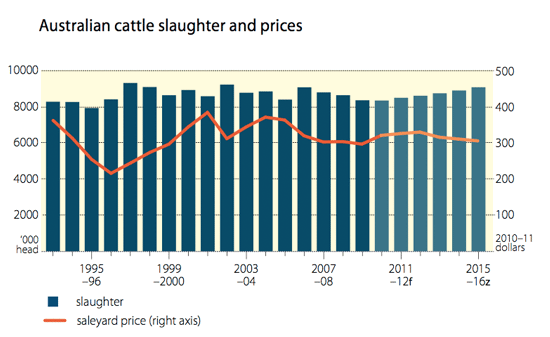
Beef exports are forecast to increase by 2 per cent in 2011–12 to 930000 tonnes. This forecast includes an increase in the share of beef exports destined to developing markets, such as the Russian Federation and those in South-East Asia.
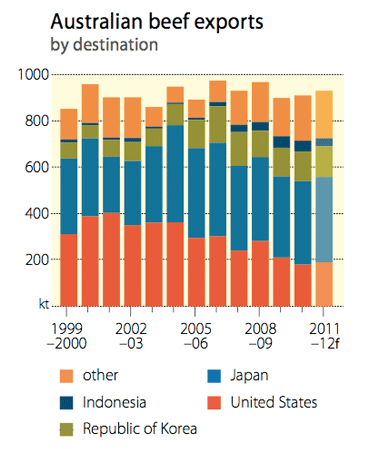
Over the five years to 2009–10, the share of Australian beef exports to developing markets increased from 8 per cent to almost 24 per cent of total exports. This change reflects higher income growth and an associated increase in demand for beef in these markets, compared with Australia’s major OECD beef markets of Japan, the United States and the Republic of Korea. In 2011–12, continued growth in import demand in developing markets is expected to result in their share reaching around 26 per cent of total Australian beef exports.
Over the medium term, Australian beef exports are forecast to increase moderately to be around 1.03 million tonnes by 2015–16. Beef exports to the major OECD markets are expected to reach 768 000 tonnes by the end of the outlook period.
Australian beef exports to Japan are forecast to rise by 3 per cent in 2010–11 to 360 000 tonnes and by a further 2 per cent in 2011–12 to 368 000 tonnes. While Japan’s total beef imports are forecast to increase over this period, most of the increase is expected to be met by US beef imports. In the Japanese market, the United States has been steadily regaining the market share it lost in the early 2000s.
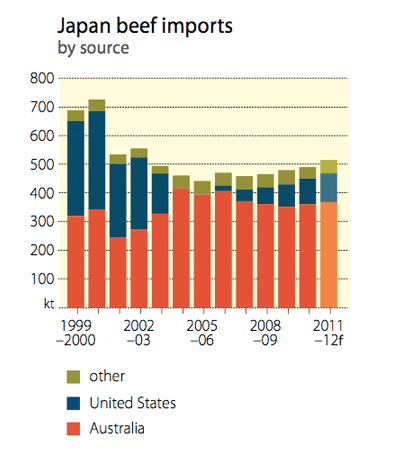
Over the period July to November 2010, Japan’s total imports of beef grew year-on-year by 8 per cent to more than 225 000 tonnes. Over the same period, the United States achieved a year-on-year rise of 26 per cent in its beef exports to Japan to around 47 000 tonnes, while beef imports from Australia remained largely unchanged at around 152000 tonnes. The share of grain-fed beef declined to 36 per cent of total imports from Australia over this period, compared with 38 per cent in 2009–10.
Current total beef consumption in Japan is 23 per cent smaller than it was in 2000, mainly as a result of health concerns following the discovery of bovine spongiform encephalopathy in both the Japanese and US herds in the early 2000s. These health concerns led Japanese consumers to reduce their beef consumption and increase their consumption of substitute meats such as pork and poultry. Japanese beef consumption, on a per person basis, has recovered partially over the second half of the 2000s but still remains relatively low. Per person consumption of beef is estimated to have been around 9.5 kilograms in 2010, well below the 12.3 kilograms in 2000. Further recovery in per person consumption of beef is expected over the projection period. However, the effect on total beef consumption will be partially offset by a continued decline in the Japanese population.
Australian beef exports to Japan are projected to increase moderately over the medium term to reach around 390 000 tonnes by 2015–16. Underlying this projected increase is the assumption that Japan will continue to restrict US beef imports to beef from cattle less than 21 months of age. If this restriction is removed, there could be increased competition from US beef in the Japanese market.
Australian beef exports to the United States are forecast to fall by around 15 per cent in 2010–11 to 180 000 tonnes, before increasing by 6 per cent in 2011–12 to 190 000 tonnes. Import demand in the United States for manufacturing beef is expected to rise in 2011–12, mainly reflecting constrained domestic supplies.
Currently, the US cattle herd is around 92 million head, its lowest in around 50 years. Notably, the rate of slaughter of young replacement cows in the United States has increased sharply in recent months, which suggests that the US herd may decline further in the short term. The United States Department of Agriculture forecasts that US beef production and exports will fall by 2 per cent and 3 per cent, respectively, in 2011.
Over the medium term, Australian beef exports to the United States are projected to increase to 230 000 tonnes by 2015–16. Export returns to the US market are projected to improve as strong US demand and limited domestic supplies are expected to drive US beef prices higher.
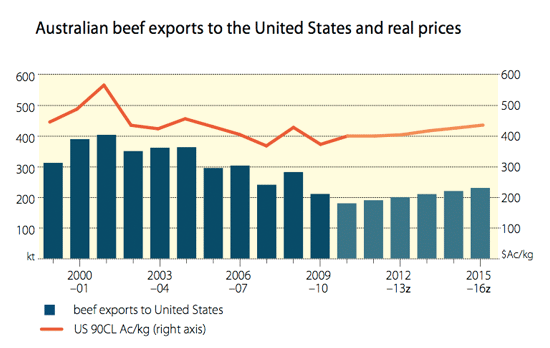
An assumed depreciation of the Australian dollar toward the end of the projection period is also expected to improve returns for Australian exporters.
Korean beef imports to growAustralian exports of beef to the Republic of Korea are forecast to increase by 3 per cent in 2010–11 to 128 000 tonnes and by a further 3 per cent in 2011–12 to 132 000 tonnes. Imports of beef by the Republic of Korea have been growing steadily in response to economic recovery since the global economic downturn in 2009. Also contributing to increased imports has been an outbreak of foot and mouth disease in Korea’s domestic herd that resulted in a cull of around 150 000 cattle.
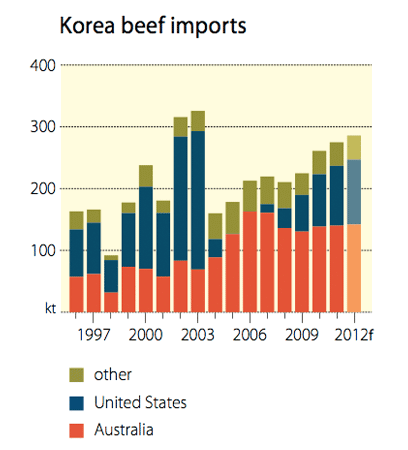
Growth in Australian exports to the Republic of Korea is expected to be modest because the United States has been steadily regaining the market share it lost in the early 2000s. Between July and December 2010, Korean beef imports were up by 12 per cent year-on-year to more than 136 000 tonnes. While imports of US beef were up year-on-year by 33 per cent, to 47000 tonnes, imports of Australian beef were up by only 5 per cent to 74000 tonnes.
Over the medium term, Australian beef exports to the Republic of Korea are projected to grow modestly, to around 148 000 tonnes in 2015–16. This projected growth in beef exports is expected to be driven mainly by growth in household incomes over the medium term. Nevertheless, strong competition from US beef is expected to continue, and this has the potential to weaken demand growth for Australian beef in the Korean market.
Australian exports to the Russian Federation are forecast to grow by more than 140 per cent in 2010–11 to around 60000 tonnes and by a further 8 per cent in 2011–12 to around 65000 tonnes. The growth in imports of Australian beef to this market mainly reflects higher beef demand as a result of rising incomes and lower beef imports from Brazil and Argentina.
Imports of Australian beef are expected to increase over the next few years to reach 80 000 tonnes in 2015–16. Despite government programs aimed at increasing domestic beef production in the Russian Federation, growth in domestic consumption is expected to exceed growth in domestic production, leading to a continued increase in beef import demand.
The Indonesian Government advised in January 2011 its intention to limit Australian live exports to Indonesia to around 500 000 head in 2011. This represents a 30 per cent fall in live exports to this market in 2010–11 compared with 2009–10. If this policy is strictly enforced (a review is expected in mid-2011), live cattle exports will remain at this level in 2011–12 and over the medium term.
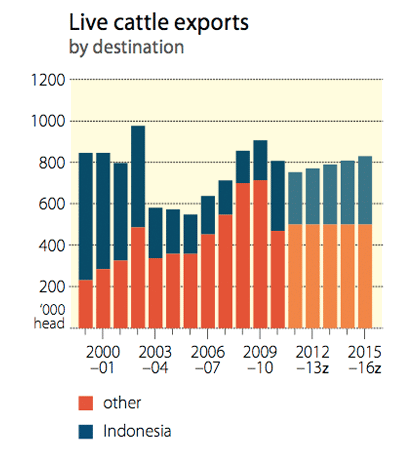
In January 2011, the Indonesian Government also moved to limit total beef imports to 50000 tonnes for 2011 from all sources. As a result, Australia’s exports of beef to Indonesia are expected to fall by 6 per cent in 2010–11 to 47000 tonnes, before declining by a further 25 per cent to 35000 tonnes in 2011–12. Assuming this limit remains in place, Australia’s beef exports to Indonesia will remain around 35 000 tonnes a year over the outlook period.
Any future growth in exports of beef and live cattle to Indonesia will depend on the removal of the above import restrictions. Over the past few years, the Indonesian market has become increasingly important for Australia’s northern cattle industry. Given strong growth in Indonesian consumer demand for beef, these import restrictions represent a major hurdle for
Australian beef and live exporters. Even with import restrictions in place, there remains a possibility that the Indonesia market will become more keenly contested by other beef exporting countries.

| TheCattleSite News Desk |


